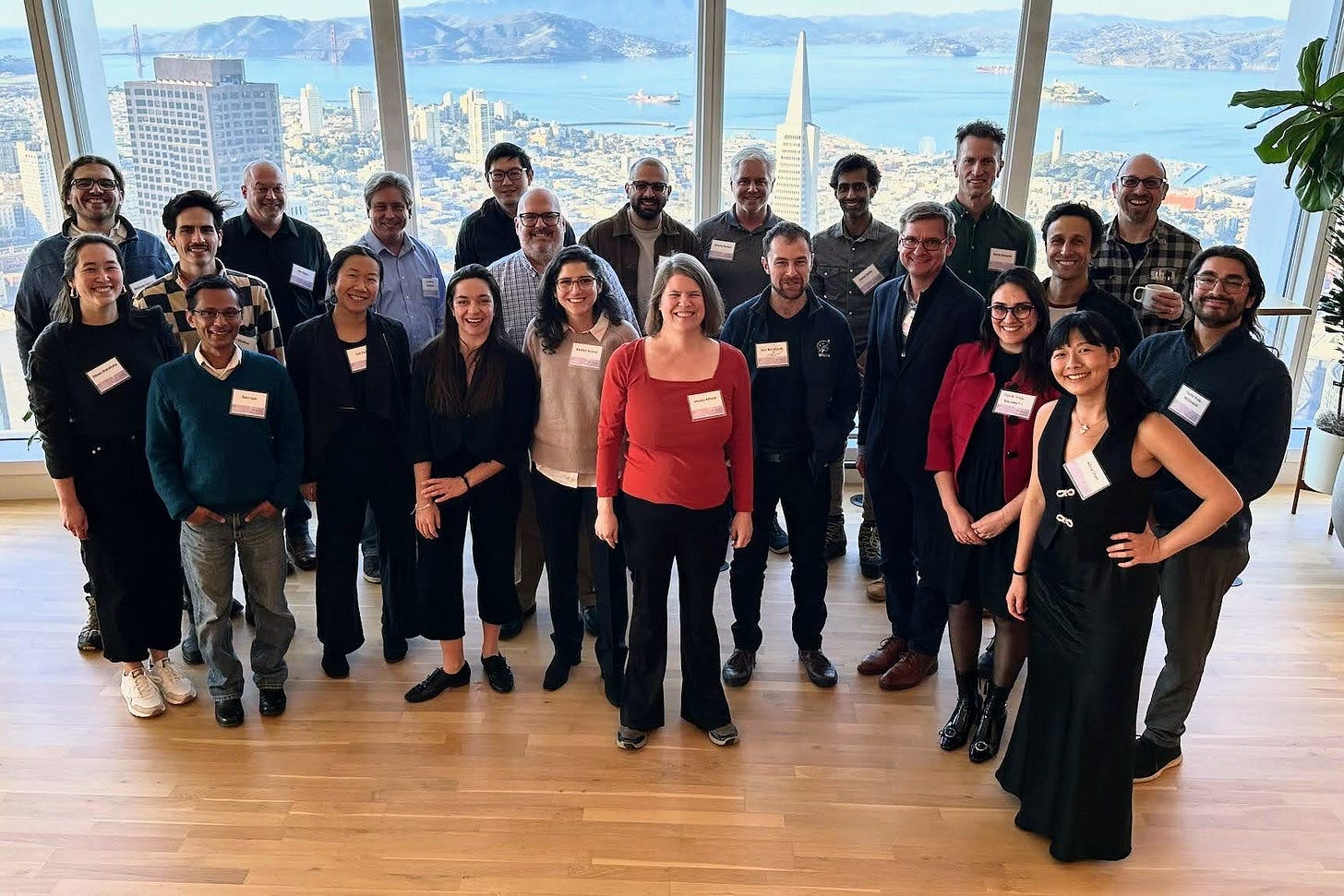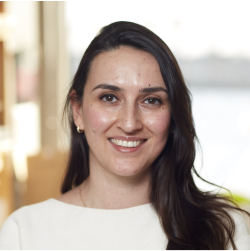Meet the 2025 Brains Fellows
We’re excited to introduce the 2025 class of Brains Fellows!
If you find any of their ideas particularly exciting or intriguing, please get in touch with them via LinkedIn (linked to in their names) or email brains@spec.tech and we’ll route you correctly.
Alina Chan
Alina is building an atlas of research that can cause pandemics, with the objective of partnering with governments, funding agencies, policy organizations, advocacy groups, and other important stakeholders to track and regulate such activities. This project will solve the key challenge of low visibility into risky pathogen research and empower data-driven prevention and surveillance of both natural and research-related outbreaks. It will establish a new way of collecting, organizing, and generating complex and holistic scientific knowledge, with a central mission to protect the world against future laboratory-based outbreaks.
About Alina
Alina Chan, Ph.D., was a scientific advisor and viral vector engineer at the Broad Institute of MIT & Harvard. She is a recent Broad Ignite fellow and Human Frontier Science Program fellow with a background in medical genetics, synthetic biology, and genetic engineering. During the pandemic, Dr. Chan investigated problems relevant to finding the origin of the SARS-CoV-2 virus and co-authored Viral: The Search for the Origin of COVID-19 with Matt Ridley. In 2022, she joined the Pathogens Project Taskforce organized by the Bulletin of the Atomic Scientists to generate new thinking on responsible high-risk pathogen research.
Blake Courter
Blake Courter is building open source engineering tools that work more effectively with modern data science. Engineering innovation has become stifled by fragmentation across design, simulation, and manufacturing, whose siloed, proprietary databases fail to model or include customer need and design intent. If we can make engineering knowledge universally computable, we remove the bottleneck between engineering and AI, unlocking generative mechanical engineering.
About Blake
Blake Courter has led innovation in engineering software for three decades. As CTO and Head of Product at nTop, he established the category of field-driven, generative implicit design. As founder of SpaceClaim (now ANSYS Discovery), he created the first interactive direct editing CAD system, an approach later adopted across the industry. At GrabCAD, he developed the first cloud-based collaborative PDM system, growing the user community to 8M users. Currently, through Gradient Control Laboratories, he continues advancing implicit modeling technology while advising numerous engineering software companies.
Christina Last
Christina is building Causal Earth: a Causal machine learning model to transform our understanding of the Earth System. This AI model will detect point source emissions and their influence on short-term weather and distant climate states. As the world enters a period of accelerated climate change, we need to define scientifically robust, open modelling frameworks to delay, or avert, climate tipping points to become a meaningfully permanent species on this planet. Causal Earth will function as an alarm system for geoengineering, helping governments and geoengineering initiatives collaborate to safely avert disastrous climate tipping points.
About Christina
Christina Last is a Machine Learning Scientist at Mila, the Quebec AI Institute, where she researches climate forecasting using AI and causality under the supervision of Prof. David Rolnick. During her US-UK Fulbright Fellowship at MIT, she completed her Postgraduate degree under the supervision of Prof. George Barbastathis as a member of the 3D Optics lab, where she developed novel computer vision methods to monitor urban emissions. Christina has developed software for secure data sharing for the UK Government and supports their climate security initiatives. She developed the first open source air pollution prediction model for the UN, and has informed investigations into environmental crime in the Guardian and Al Jazeera.
David Cohen-Tanugi
David Cohen-Tanugi is developing a research program to develop solutions for electronic waste recycling that will dramatically increase US independence in critical minerals. The program aims to demonstrate a 95% collection rate for end-of-life electronics and a 10x more sustainable method of extracting critical metals from e-waste, including copper, palladium, and neodymium. David has been developing this program concept within MIT's venture studio for the past year, in partnership with faculty members in materials science & engineering. The research program will focus on drastically advancing the field of component and material characterization in mixed material streams, enabling intelligent processing decisions in real-time. Within five years, the program will demonstrate new technical pathways to unlocking a far greater collection rate of discarded electronics and to extract critical minerals from end-of-life electronics using processes that can realistically be scaled in the USA.
About David
David leads the Clean Energy & Fusion program at MIT Proto Ventures, the venture studio of the Massachusetts Institute of Technology. David has a decade of startup experience and holds a Ph.D. in Materials Science & Engineering from MIT.
Eder Medina
Eder is building an end-to-end smart manufacturing system that uses evolution and adaptation to enable efficient and scalable production of parts. The physical manufacturing platform leverages recent advances in machine learning and artificial intelligence to capture and expand expert knowledge that is often siloed or missed in current systems. This will drive future innovation, reduce waste, minimize energy consumption and ultimately lower costs.
About Eder
Eder Medina is dedicated to advancing innovation at the intersection of machine learning, embodied intelligence, and the application of artificial intelligence in engineering and manufacturing. He holds a doctoral degree in engineering science, specializing in the optimization, manufacturing, and experimental testing of mechanical systems, and completed postdoctoral research in machine learning for autonomous manufacturing systems. Driven by a passion for creating adaptive, interdisciplinary engineering solutions, his ultimate goal is to design complex systems capable of evolution and adaptation, contributing to more efficient manufacturing processes.
Garth Edwards
Garth is developing technology to convert intermittent solar or wind energy onsite into ammonia to enable the safe, cheap transport of clean energy globally using existing infrastructure - without wires. The high cost of stationary energy storage and transmission lines causes a large amount of clean energy to be wasted, negatively impacting clean energy project economics and hindering global progress towards net zero. Garth’s energy conversion research is being funded by the California Energy Commission (CalSEED) and he’s currently collaborating with Lawrence Berkeley National Laboratory.
About Garth
Garth Edwards is an engineer and entrepreneur with deep experience in complex systems. He was previously a lead chemical (process) engineer for major energy corporations on multi-billion dollar projects that involved high risk, high technical complexity with critical safety regulations. On top of a foundation of industrial hardware design & engineering, Garth has deep experience in big tech, big data and data security (as a Google Product Lead) - essential for the disruption of today’s energy/chemical industry to help solve climate challenges at a global scale.
Hourinaz Behesti
Hourinaz is developing tools and methodologies to map how molecular pathways in the brain change over time. This map would have implications for currently untreatable neuropsychiatric conditions from autism to addiction. Almost one billion people will be affected by disorders of the brain by 2030 and most won’t have treatments that work. If we could generate precision maps of patient biology, linking molecules to clinical symptom severity, we will unlock novel drug targets and biomarkers, and enable stratification of patients in an entirely new way for better clinical trial design. This precision approach also has the potential to fold “rare” diseases into more common categories and remove the current economic barriers for rare disease drug development.
About Hourinaz
Hourinaz is a neuro and stem cell scientist. Born in Iran, raised in Sweden, and educated in the UK, she came to the US for a postdoc at the Rockefeller University in NYC to study autism. There, she discovered a novel cell biological pathway in autism and developed some of the first methodologies to engineer specific neuronal subclasses from patient induced pluripotent stem cells. She advises rare neurodevelopmental disease patient organizations in translational research and drug development and recently started Hebbian Bio to develop a precision technology platform that reduces biological complexity to accelerate drug development for neuro patients.
Jehad Abed
Jehad aims to accelerate the clean energy transition by providing the community with large lab datasets to enable AI models that cut critical materials discovery from 10 years to 1. These materials can reduce the cost and improve the performance of carbon capture, upcycling chemical waste, and manufacturing green steel, reducing more than 15% of annual CO2 emissions. This work is the continuation of pilot projects at Meta and the University of Toronto to scale up data generation of lab materials, with published findings urging the need to build datasets that are 100 times larger for AI to make a significant impact.
About Jehad
Jehad is a researcher at Meta’s Fundamental AI Research (FAIR), specializing at the interface of materials science, artificial intelligence, and energy. He earned his Ph.D. from the University of Toronto, where he pioneered advanced materials for green hydrogen production and CO2 upcycling. He also spearheaded a program at the Alliance for AI-Accelerated Materials Discovery (A3MD) leveraging automated labs to accelerate materials discovery. His work earned him recognition as an Emerging Hydrogen Leader by the Canadian Hydrogen Convention and as a Grad-to-Watch (Toronto). He was also a finalist in the Carbon XPRIZE, where he helped build the largest pilot plant for CO2-to-ethylene conversion.
Jeremy Barton
Jeremy is developing electrically controlled nanomachines to manipulate materials and chemical reactions at the molecular scale. These tools could enable breakthroughs in quantum computing, biotech, and beyond. The program develops chemistry-controlling processes using scanning probe microscopy while building increasingly capable computer-controlled nanomachines through biomolecular-electronic integration. This approach merges biology’s precision with electronics’ programmability. Each advance in catalyzed mechanosynthesis and nanomanipulator capabilities opens near-term applications in quantum computing and biotech, all while moving closer to full-scale molecular manufacturing.
About Jeremy
Jeremy Barton, Ph.D., is a physical chemist with extensive experience building and managing interdisciplinary research and development projects in atomically precise manufacturing. A science generalist, Jeremy excels in integrating diverse fields to address complex challenges, with a focus on advancing open-source nanomechanics research. Jeremy is committed to fostering innovative solutions in manufacturing while tackling environmental sustainability. With a sharp technical acumen and collaborative mindset, Jeremy brings a strategic approach to science and its transformative potential for society.
Kaitlyn Suarez
Kaitlyn is building technology to transfer power and data directly through the ground. This technology could transform power deployment and unlock an underground, wireless grid. Her goal is to realize the unfulfilled dreams of a world run by wireless and renewable electricity with the aim of all human prosperity. With a working prototype complete, she is ready to scale and plans to see this work completed via a focused research organization led by compassionate thinkers and visionaries.
About Kaitlyn
Kaitlyn Suarez earned her Ph.D. and M.S. in geosciences as a National Science Foundation Graduate Research fellow at the University of Massachusetts Amherst and holds a B.S. in geology from Union College in New York State. Suarez is supported by an Activate fellowship and Rose Rock Bridge.
Kasim Rafiq
Kasim is developing open-source AI models that forecast where animals move, for any species, anywhere. By leveraging billions of existing GPS data points on animal movements, integrating environmental sensing, and applying advances in foundation models, Kasim believes it is possible to create generalisable models that forecast movements across days, seasons, and years; much like we predict the weather. These models would address a critical gap in current approaches—insufficient data in most regions to forecast animal movements at actionable scales. They would enable policymakers and conservationists to identify and preempt public health risks from disease-carrying wildlife, design climate-resilient conservation strategies, and track and mitigate wildlife-related risks to agriculture in near-real time.
About Kasim
Kasim is a wildlife scientist dedicated to advancing our understanding and conservation of the natural world through cutting-edge technology, collaborative science, and on-the-ground fieldwork. With over a decade of experience, his efforts include leading teams to develop a cost-effective wildlife monitoring method using tourist photographs, using animal-worn sensors to track climate impacts on predators, and applying AI to decode complex animal behaviours. A Nat Geo Explorer, Fulbright Alumnus, and Washington Research Foundation Fellow, Kasim’s unique blend of field expertise, technological innovation, and science leadership places him to deliver ambitious research with large-scale impacts.
Mehmet Sencan
Mehmet is creating designs for open, tamper-proof compute hardware (e.g. GPUs) that can locally enforce policies like export controls or safety evaluations. This hardware could encode laws restricting certain usages of AI or requiring use of safety best-practices or enable servers that can remain secure even if a hacker has physical access to them. These capabilities could be accomplished if the hardware itself could check usage against policies, and disable itself in the event of a violation. To date, Mehmet has hosted workshops and demonstrated prototypes in AI Security Forum and other venues; he has also raised philanthropic seed funding for the effort.
About Mehmet
Mehmet is taking a hardware backstop approach to security and governance of AI compute. Since finishing his BS at Caltech in Applied Physics, he has been pushing chip and manufacturing technology capabilities for over a decade, previously as a full-stack hardware developer, running biosensor manufacturing processes all the way from sensor design to medical device implantation (while ensuring functionality, cost-efficacy, and manufacturability).
Mervin Zhao
Mervin is developing approaches to scale and process new conductive materials, like carbon nanotubes, into wires to replace copper. Electrification is key to the energy transition, but copper will soon become the largest barrier to electrification, with supply only meeting 80% of demand in 2030. This program will focus on the industrial scalability of alternative conductors using renewable feedstocks, as well as the processing of these materials into wires to achieve copper-level performance and price.
About Mervin
Dr. Mervin Zhao is a materials scientist who has worked on nanotechnology for electronics, energy, and health applications. He is currently a technical advisor for the Advanced Research Projects Agency – Energy (ARPA-E) where he has supported development of programs in geologic hydrogen, AI for catalysis, electrochemical membranes, and direct air capture. Previously, he led the research and development team at a startup commercializing nanofiber filters. He received his M.S. and Ph.D. in materials science from UC Berkeley.
Ravi Jain
Ravi is working to uncover the molecular pathways that govern how different regions of the brain communicate, with the ultimate goal of uncovering mechanisms that drive age-related changes in cognitive health. Leveraging the state-of-the-art in brain organoids, AI analysis of (brain) neural networks, and spatial proteomics, the program will pinpoint protein targets that could be leveraged to prevent or slow neurodegeneration, potentially developing breakthrough therapies for age-related cognitive decline and Alzheimer's.
About Ravi
Ravi Jain is a strategic executive leader and published scientist with over 20 years of experience in the life sciences and technology sectors. He specializes in commercializing innovative solutions and leading high-impact projects. Ravi has a proven track record in R&D, data science, and machine learning applications for therapeutic discovery. He has successfully built and managed cross-functional teams, secured significant funding, and developed strategic partnerships. With a PhD in Bioinformatics & Molecular Evolution from UCLA and 23 issued patents, Ravi is dedicated to advancing science and technology to improve lives and organizational success.
Rik Obiso
PANDORA – Pathogen and Anomaly Nexus for Detection and Optimized Rapid Assessment aims to transform global health diagnostics by bridging molecular precision with next-generation sequencing depth. By creating a universal, accessible platform, PANDORA detects disease biomarkers with high sensitivity and specificity, empowering proactive health decision-making. This revolutionary approach ensures actionable insights are available to everyone, everywhere, at an affordable cost.
PANDORA seeks to move diagnostics from reactive to proactive, enabling earlier intervention and better health outcomes. The platform is designed to integrate seamlessly into both advanced clinical settings and resource-limited environments, offering a scalable, infinitely multiplexed solution for detecting the earliest markers of diseases—be it infections, cancer, or rare conditions. PANDORA redefines diagnostics as the cornerstone of global health equity and preparedness.
About Rik
Rik is a Chief Scientist at Johns Hopkins University Applied Physics Laboratory, where he leads innovative efforts in global health security and infectious disease research. With more than 25 years of experience, Rik is a passionate leader who combines technical expertise with a practical approach to solving real-world challenges. He has a proven track record of developing cutting-edge tools, mentoring diverse international teams, and inspiring others to discover their unique genius. His drive to bridge advanced science with impactful health solutions has made him a leader in transforming global health. Currently, he’s focused on creating tools that promise to revolutionize public health responses by making testing faster, more affordable, and accessible worldwide.
Taylor Kulp-McDowall
Taylor is building safeguards that make it substantially harder to misuse open-source AI models. It is currently trivial to circumvent the safety protections of open-source AI models, meaning malicious actors can repurpose them to enable dangerous national security threats such as malware or bioweapons development. By combining cryptographic techniques with recent advancements enabling high-level control over AI model behavior, novel safeguards could “tamperproof” open-source models and provide robust, scalable protections against a wide range of adversaries. These safeguards would serve as a foundational layer of defense to prevent the proliferation of AI-enabled national security threats. Taylor brings extensive experience advising AI security initiatives across the ARPAs, where he has a history of designing and overseeing AI security research programs.
About Taylor
Taylor Kulp-McDowall is a machine learning engineer and research manager focused on AI security and AI safety. Currently, Taylor is a lead technologist at Booz Allen Hamilton, supporting research to mitigate vulnerabilities in AI systems and improve AI security evaluations. His previous work includes developing machine learning models for biosecurity with Harvard's George Church Lab and building data pipelines and AI solutions at Keystone Strategy. A Princeton physics graduate, Taylor has expertise in adversarial machine learning, AI security, and driving research at the intersection of academia, national security, and private industry.


















